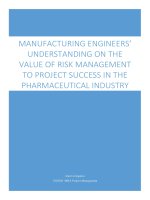Lecture Health economics - Chapter 11: The pharmaceutical industry
Bạn đang xem bản rút gọn của tài liệu. Xem và tải ngay bản đầy đủ của tài liệu tại đây (535.99 KB, 36 trang )
The Pharmaceutical Industry
Professor Vivian Ho
Health Economics
Fall 2009
Outline
Competitiveness of the pharmaceutical
industry
Conduct
Performance
Benefits of Drugs
Reduce mortality
Reduce morbidity/improve quality of life
Reduce cost of treating diseases
Industry Structure
# and size distribution of sellers
Buyers’ side characteristics
Barriers to entry
Government regulation
Top 10 U.S. Prescription Drug Sellers, 2008
Company
Sales $b
Pfizer
20.5
GlaxoSmithKline
18.4
AstraZeneca
16.3
Johnson & Johnson
16.0
Merck & Co
15.5
Amgen
13.4
Hoffman-LaRoche (incl Genentech) 13.1
Novartis
12.4
Lilly
11.4
Sanofi-Aventis
11.0
4-Firm Concentration Ratios 2002
Industry
4-firm CR %
Apparel
18.4
Basic Chemicals
18.3
Computer software
34.1
Food
14.8
Footwear
34.5
Furniture
18..7
Automobile
87.3
Pharmaceuticals
33.6
Can competition be accurate
measured at the industry level?
Most drugs are not substitutes to the
patient
The relevant product market is the
therapeutic market
Only a few major drugs compete in most
therapeutic markets
Concentration ratios at this level are higher
than for industry as a whole
Concentration Ratios
for Therapeutic Markets, 2006
Therapeutic Market
Four-Firm Ratio
Antidepressants
87*
Antihistamines
99*
Antihyperlipidemics
73*
Antihypertensives
81*
Antivirals
80*
Gastrointestinal Diseases
91*
*Includes “Generics” as a top-4 firm
Express Scripts Drug Trend Report, 2006
Firms tend to make most profits from
a few key drugs
Top 3 Drugs as a % of Worldwide
6 Month Prescription Sales, 2007
Percent of
Company
Revenues
Glaxo Smith Kline
29.1
Pfizer
40.9
Johnson & Johnson
44.7
Percent of
Net Revenues
Wyeth
55.5
Bristol-Myers Squibb
47.5
Merck & Co.
44.3
The Buyer Side
Buyers of Prescription Drugs, 2007
Expend.
Source
($billions) Percent
Total
227.4
100.0%
All private
146.6
64.5
Out-of-pocket
47.5
20.9
Private insurance
99.1
43.6
All government
80.8
35.5
Federal
66.5
29.2
State
14.3
6.3
Prescription Drugs as a Percentage of U.S. National
Health Expenditures, 1960 - 2007
Share of Health
Expenditures
11%
9%
9.7%
9.4%
10.3% 10.1%
8.9%
8.8%
6%
10.1%
9.8% 10.0% 10.0%
7.3%
6.0%
4%
5.6%
4.7%
6.0%
5.0%
2%
0%
1960 1965 1970 1975 1980 1985 1990 1995 2000 2001 2002 2003 2004 2005 2006 2007
www.cms.hhs.gov
How 3rd parties influence drug demand
Even if consumers exert little influence
over drug choice, 3rd parties are
making the market more competitive
Formularies - list of selected drugs
physicians may prescribe
Used by hospitals to limit inventories and
costs
Used by most HMOs and many PPOs
Used by many state Medicaid programs
Drug utilization review
Used by insurers to enforce formularies,
identify inappropriate prescribing practices
Government influence
1990 Omnibus Budget Reconciliation Act Federal funding provided for drug only if
state Medicaid program receives
manufacturer rebate agreement
Government influence (cont.)
1992 Veterans Health Care Act - price
discounts for Federal Supply Schedule,
VA, Dept. of Defense
These programs may restrict costs for
government, but drug firms may be forced
to raise nonfederal prices
“…managed care emphasizes less-expensive, preventive
types of treatment”
“The rate of growth for drugs to treat high blood
pressure and high cholesterol in certain managed-care
strongholds on the West Cost has gone off the charts”
WSJ 10/17/96
“Consumers
in the $94
billion prescription drug
market are mostly
indifferent to price.
What will happen when
they all become budget
conscious?
Forbes 4/5/99
Pharmacy Benefit Managers
General Strengths
Intermediaries that purchase drugs from
manufacturers and pharmacies at a
reduced price for health insurers
PBMs provide drugs at lower costs
Achieve
econ. of scale in pharmacy
benefits by serving multiple plan sponsors
Large market share on buyer’s side
stronger negotiating power w/ drug
companies
Pharmacy Benefit Managers
General Strengths
PBMs can use their patient information
to their strategic advantage
e.g. Medco’s 60m patients
How drugs prescribed, used, impact on
disease
Can prevent inappropriate drug
interactions, under/over medication
Vertical Integration
Brand name drug companies were
purchasing PBMs
Estimated
Date
Acquirer
Target
Exp. ($m)
Nov-93 Merck
Medco
$6,600
May-94 SmithKline Beecham Diversified
$4,000
Jul-94 Eli Lilly
PCS Health
$2,925
Vertical Integration
Good or bad idea?
Buy
the information, not the PBM
“Industry consultants and Medco competitors
argue that Merck could have bought that
information from Medco or others in the field
without buying the company.” NYT 8/5/93
Critics
argue that PBMs will only serve to
lower prescription pharmaceutical prices
WSJ 2/2/98
Vertical Integration
Comments from Roy Vagelos, former
Merck CEO
“In
classic terms of competition, we could see
that the power of the buyers was growing…PBMs
were…bringing together the person who chooses
the drug and the person who pays for the drug.”
“Having
salespeople visit doctors’ offices does
not allow us to reach PBMs, HMOs, or plan
sponsors -- the major players in the emerging
market.”
Vertical Integration
Merck bought Medco as a response to
managed care
Strategic attempt to market power. How?
Followup on patients w/ chronic illness
who may stop taking prescribed meds
Position Merck drugs favorably on
formulary
e.g. lower patient copay, or lower cost to plan
sponsor
Vertical Integration
•
In 2001, Medco accounted for $26b of
Merck’s $46b sales
•
Medco filled 537m prescriptions in 2001
•
But profit margins for Medco <3%
Vertical Integration
Regulators worried that patients and
employers would be hurt by this type of
vertical integration
Regulators
required separate management of
drug sales and PBM operations
Merck spun off Medco in 2003









